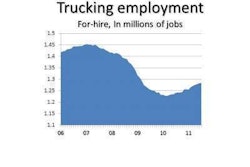Training on demand
New technologies add virtual driving instructors
By Aaron Huff
In an ideal world, training drivers in safety, fuel economy and other performance areas would be an automated process, similar to how fleets track shipments or invoice customers. Surprisingly, such a scenario is close to reality.
Today, some fleets already use software to screen driver applicants automatically and compress the hiring process. Before drivers arrive for work, they already have completed training and other orientation tasks online.
Some fleets also assess driver skills using simulation technology. Once skills are assessed, they can assign computer-based training to fill the gaps. Once drivers hit the road, training can be assigned automatically using data collected from onboard computers ranging from poor fuel economy to critical safety events such as speeding or hard braking.
While no technology can replace traditional instructor-led training completely, it makes it possible for instructors to conduct quicker assessments, target their training for each driver and direct human resources to the most at-risk drivers.
Focused training
In January, J.J. Keller launched an interactive on-demand training center at www.jjkellertraining.com. The portal includes a learning management system (LMS) that fleet managers can use to enroll drivers in courses – both basic and master levels – and track their progress. The system can track when drivers logged in, for how long, what courses they completed and their scores. Any “manual” classroom training also can be recorded in the LMS.
Carriers can customize the front page of the portal that drivers see when they login to complete assigned courses, such as creating a welcome message with a company logo. Because the training is interactive, drivers can complete the online courses at their own pace.
“It is really designed for maximum efficiency,” says Joel Landsverd, senior product development specialist for J.J. Keller.
Vertical Alliance Group has an online LMS called Infiniti that includes a resource center with more than 200 training videos for transportation companies. The LMS also allows companies to import their own material, such as videos and PowerPoint slides, and develop their own test questions. A subscription to Infiniti comes with “all-you-can-eat” training, says Bob Brittan, director of marketing.
Currently, carriers that use the Qualcomm MCP200 onboard computing platform can have drivers take training in the cab. Vertical Alliance Group is working with EBE Technologies to automate the process of assigning training to drivers based on real-time performance information from speeding, hard braking and other “triggers” captured by onboard computers, Brittan says.
Simulation screening
Simulation technology can be used to assess drivers – both new hires and tenured employees – faster and more thoroughly than a traditional in-vehicle instructor-led approach.
“In less than five minutes, we can tell if you should hire a guy or not,” says Mike Reardon, director of business development for Virage Simulation of Montreal, Canada. Virage and other companies that develop simulation-based training can add scenarios to the curriculum that exceed some commercial driver’s license programs.
“Our curriculum incorporates the latest adult learning and instructional technology,” Reardon says. “We then populate our curriculum with training scenarios that begin with an end in mind and provide an indisputable visual and objective measure of driving performance.”
Virage simulators produce reports for a trainer to evaluate a driver’s tendencies in shifting, speed, space management and other areas. Virage also can aggregate data from its simulators with actual on-road safety and performance data captured by onboard computers to chart performance improvements.
MPRI, an L-3 company, develops simulation-based driver training for its full-size TranSim VS hardware. Fleets that use the simulators, such as Schneider National, are able to assess driver skills and train across a variety of areas, including pretrip inspections, speed and space management, backing, fuel economy and distracted driving.
Simulation technology can help assess drivers faster and thoroughly.
In the past six months, MPRI has expanded its simulation training with custom online training modules designed to help clients optimize existing investments in simulators, onboard computers, safety management systems and other technologies.
The online modules can be customized for a client’s specific objectives for safety, productivity and fuel performance. The online courses use the latest in adult learning technology with short, focused and highly interactive content, says Laura McMillan, MPRI’s program manager of commercial training and curriculum development.
A driver that completes a skills assessment in the TranSim VS simulator receives a report card. MPRI’s LMS assigns online courses to the driver based on individual needs; the courses then can be taken on any PC or through an onboard computer.
This approach enables companies to focus instructor-led training on drivers with the most need, McMillan says. Fleets using the technology have seen a 42 percent improvement in training time compared to the traditional instructor-led approach, she says.
Driver training typically requires a combination of methods to be most effective. Technologies such as computer-based courses, simulation and LMS help carriers get more productivity from their human resources and also leverage the latest onboard computing platforms to deliver on-demand training to drivers.
Arsenault adds Instant Recall to Dossier
Arsenault Associates announced Instant Recall, a new function of Dossier software that instantly and automatically displays maintenance history information when a new repair order is initiated. The information appears in a panel on the right side of the screen as soon as the vehicle’s ID is selected.
As more information is added to the repair order, Instant Recall automatically drills down into that vehicle’s history to match the entered information. As a result, the technician or supervisor can see if the same kind of work has been performed previously on a vehicle and when. He also can see the repair reasons and what parts were installed, and even can see a specific previously completed repair order or complete repair history – all without leaving the working screen.
“Every fleet maintenance manager knows that rework is the most expensive and time-consuming work any fleet maintenance shop can perform,” says Charles Arsenault, chief executive officer of Arsenault Associates. “A review of past maintenance histories can reduce rework and capture warranty dollars, but all too often that review is skipped.”
Instant Recall uses Vehicle Maintenance Reporting Standards codes specifically developed for the surface transportation industry. VMRS codes have been adopted by most equipment manufacturers and parts suppliers to make it easier for parts ordering, warranty recovery, defect reporting and other issues.
“If fleet managers and mechanics have instant access to maintenance history, the work they perform and the maintenance dollars that they spend won’t be a repeat of the past, and rework will all but disappear,” Arsenault says.
IN BRIEF
* PeopleNet (www.peoplenetonline.com), a provider of integrated onboard computing and mobile communications systems, announced its acquisition by Trimble; terms were not released. PeopleNet will head up Trimble’s worldwide transportation and logistics vertical. The transaction is expected to close in the third quarter of 2011.
* Aljex Software (www.aljex.com), a provider of hosted transportation management systems for third-party logistics firms and carriers, now provides unlimited server space for digitized documents and images.
* Qualcomm (www.qualcomm.com) messages now can be delivered directly as text messages to the cell phones of Prime Inc. drivers assigned to a truck operating under the Springfield, Mo.-based company’s authority.
* GreenRoad (www.greenroad.com), a provider of fleet driver performance and safety management, added new features to GreenRoad 360, including posted speed performance and reporting of idling hot spots across specific geographies and routes.
* Mobileye (www.mobileye.com) announced that its collision avoidance system was selected by Dart Transit Co. for its over-the-road fleet.
* ALK Technologies (www.alk.com) released its PC Miler 25 routing, mileage and mapping software product line. A core enhancement allows users to specify a departure or arrival date and time to calculate an ETA at stop-off points or an ETD to help meet delivery schedules.
* Comdata (www.comdata.com), a provider of electronic payment solutions, launched a new set of regulatory compliance solutions focused on driver health.











